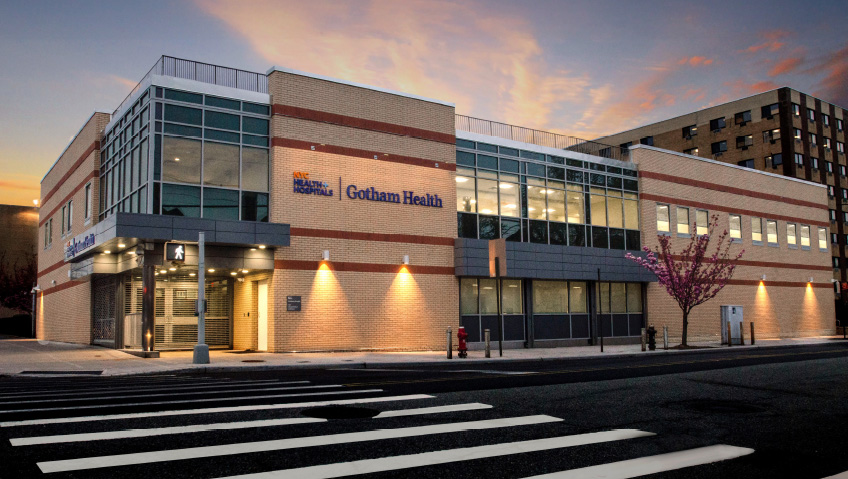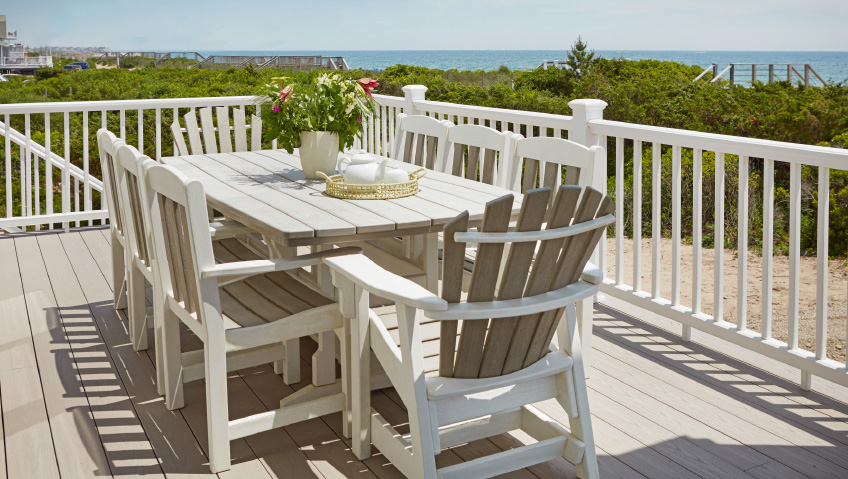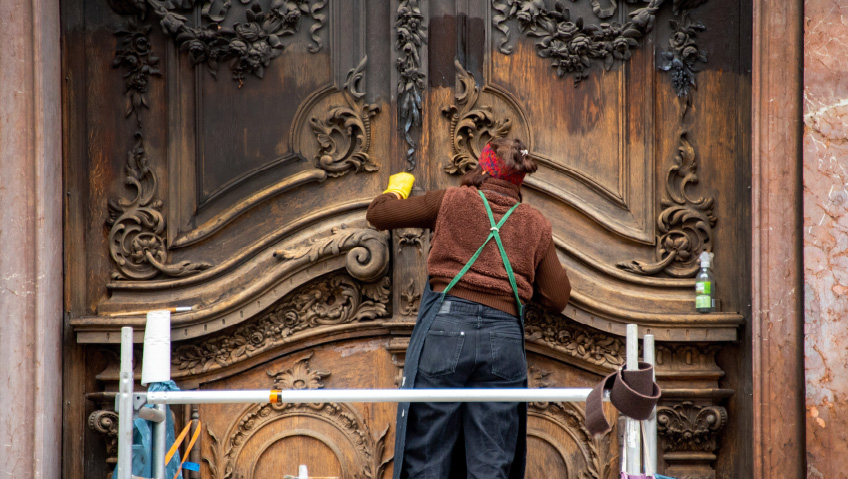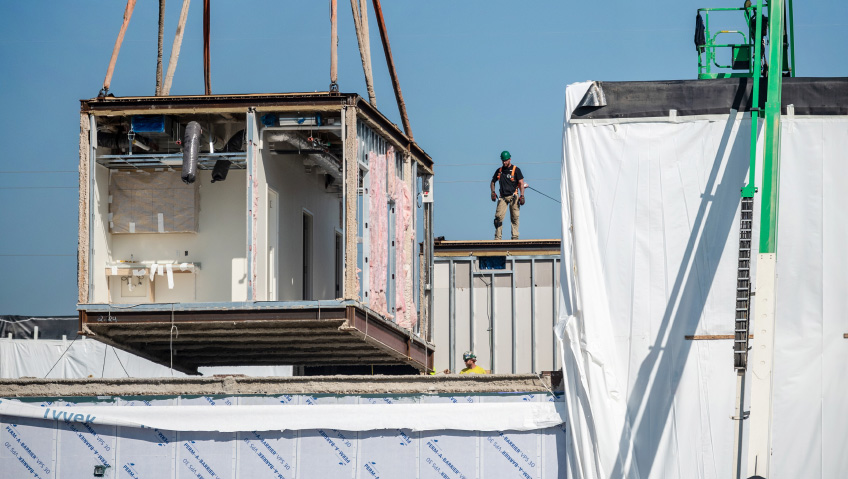“The best partnership isn’t based on the value that MODLOGIQ brings and that Axis Construction brings,” says Jim Gabriel, President and CEO of MODLOGIQ, Inc. “Real value is in the personal and professional trust we have in each other. We’re a manufacturer and a producer of off-site construction products, and Axis is a general contractor who understands that every project is still a construction project. It’s a hand-in-glove relationship.”
“Jim is 100 percent right, and it goes back to him as well,” agrees John Buongiorno, Vice President, Modular Division at Axis Construction. “We’ve known each other forever as businesspeople in the same industry; we have a very strong personal friendship, and without him and his company, we wouldn’t be able to do the complicated medical buildings we do in this industry.”
Established in 1993, Axis Construction Corporation has proven its ability to create and effectively complete projects for more than two decades with a concentration in the hospital and healthcare sectors and experience in commercial, industrial, and educational building. For its part, MODLOGIQ, spearheading a new wave of innovation in off-site modular construction and a “Build Together” approach to off-site manufacturing, produces intricate, beautiful, long-lasting modular constructions far beyond simple assembly-line techniques.
Together, the two companies are currently working on the second emergency room addition for Beth Israel Health System in the Boston area, with delivery planned for around November of this year and completion scheduled for March or April of next year.
Facing challenges head-on
Despite the valuable and productive relationship that keeps these companies progressing smoothly, labor shortages and wage legislation remain ongoing challenges across the industry, ones that affect modular building in particular. At the moment, factories like Gabriel’s are able to hire people to do non-union work at a non-prevailing rate, helping to keep costs down, which is a key benefit to modular construction. However, various states are trying to bring prevailing rates into the manufacturing facility, says Buongiorno. Prevailing wage rules apply to public projects and, when they exist, establish a minimum wage that must be provided to the majority of workers. If passed, when orders are placed with MODLOGIQ, Gabriel will have to introduce paying the given state’s prevailing rate into his plans.
“But there’s also a tremendous shortage in the overall construction industry of skilled labor, whether it be electricians, plumbers, carpenters, masons, or painters,” adds Buongiorno.
Both gentlemen have numerous years of experience in the industry, and both are seeing a serious lack of industry expertise at the moment, particularly when it comes to working with larger, modular building projects, Buongiorno tells us. “There’s just nobody really growing up in the industry anymore, because it has changed to where it’s really become almost two separate industries.”
The first of these is the relocatable, temporary buildings, office trailers, and fleet-type buildings that come in and out of lease, which is certainly a huge part of the industry. The second is the PMC model—permanent modular construction—which both Buongiorno and Gabriel are involved in. In that sector, there simply aren’t enough tradespeople who are coming up through the industry and learning all its nuances: working for a fleet; leasing and renting classroom trailers, office trailers, and smaller buildings; and getting those delivered.
“There are just not a lot of people coming into construction at all,” Buongiorno adds. “Not just trades, but project managers, construction management, and superintendents. We have a very, very difficult time finding good candidates.”
Other issues within the industry include financial constraints, with modular’s accelerated construction meaning both accelerated schedules and accelerated payments as well. “While Jim is building down at the site and needs to be paid, we’re doing the foundation work, which also needs to be paid for,” says Buongiorno. “So the client and the lender need to understand how that cash flow model is completely different than the traditional one.”
Modular construction must also—still—face down perceptions of lesser quality, with some clients not convinced that the buildings are strong and of high quality. “Jim and I can sit there all day and prove to you that they actually are more robust buildings than conventional buildings because they have to be shipped thousands of miles and not fall apart,” says Buongiorno.
Advocating for an industry
While this perception is changing, the process has been slow. Now considered a progressive method of construction, initially modular was only meant to be a temporary solution, and a perception of lesser quality—one that these companies are trying to repair—was thus born.
The industry continues to make progress here, with both the NAHB (National Association of Home Builders) and the MBI (Modular Building Institute) working to improve the perception of modular and broaden its reach. To this end, there has been some global expansion into Europe—an important part of demonstrating the viability of the industry—along with MAP, the Modular Advocacy Program, which encompasses aspects including protecting, defending, addressing, and advocating.
“Jim’s MAP program generates the funds needed to educate, promote, and in some cases even hire lobbyists to help us with some of these causes, whether to change code or adopt new codes,” adds Buongiorno. “Jim was instrumental in really pushing that program and getting the awareness there.”
“We are hyper-focused on telling the story of not just what the Modular Building Institute is, but what modular does and what its constituent members do for communities in distress in terms of recovery, relief, and rebuilding,” says Gabriel.
In a key success story, MODLOGIQ recently completed the Athens Medical Campus in Athens, Ohio, the largest permanent healthcare facility ever built using off-site modular construction in North America, a 100,000-square-foot complete standalone structure that MODLOGIQ produced and assisted in the design of, an example of exceptional quality modular construction.
A model for growth
Looking to the years ahead, both companies are aiming to not only grow their businesses but to support and strengthen the entire industry as well. “We want to move from the manufacturing of things toward the assembly of projects,” says Buongiorno. “That starts with design and a kit-of-parts strategy that allows us to be able to speed up design and then speed up the assembly of projects.”
This means creating a model that lifts all boats, as it were. It isn’t enough that a given company is able to increase its capacity and skill set; it is important to reduce the total cost of setting up new factories, period, and to geographically locate facilities in areas in need of accelerated building, such as those that have been devastated by natural disasters. The ability to move the assembly process to a near-site location doesn’t just help grow business; it recognizes how to appropriately scale the industry and how to bring more capacity online to provide greater value to communities in need.
Built on trust
All of the growth and the ingenuity that underpins these two companies has been made possible by the solid relationship that John Buongiorno and Jim Gabriel have built over the years. “In the construction world there are inherent conflicts in every step along the process, from design to final completion and commission,” Gabriel says. “What breaks down those barriers is trust. What facilitates that level of trust is, in my view, friendship and common goals.”
Buongiorno and Gabriel’s relationship is unique in terms of who they are and what’s important to them, starting with trust, leading to a shared give and take, and resulting in a successful project. “John and I have been in the industry for 30-plus years, and it’s been a long, winding path,” says Gabriel. “We want to succeed because of what it means for us as friends and as people who have worked together for a long time, and we really want that to be a repeatable model.”
Buongiorno agrees. “If it wasn’t for Jim and his firm having the willingness to push the envelope and continually having us push them to do more and more in the factory, it would just be like everybody else,” he says. “That’s what sets us apart. Integrity is paramount. Do what you say you’re going to do, whether it’s in a contract or not.”
Both companies strive to maintain a very high level of reliability, he adds, not just with each other, but with their firms and their board positions at the Modular Building Institute. “That doesn’t mean we don’t have tough conversations—we do—but you can have those tough conversations with the level of trust and respect that we have for each other, not just personally, but as organizations,” Buongiorno says.
It’s not always easy, but it’s all in an effort to continue down that path of success. “There are very few, if any, other companies that do buildings the way we do it together, and that’s special.”






